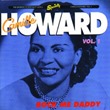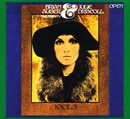 Barbara Dane (born May 12, 1927) is an American folk, blues, and jazz singer.
Barbara Dane (born May 12, 1927) is an American folk, blues, and jazz singer.
"Bessie Smith in stereo," wrote jazz critic Leonard Feather in the late 1950s. Time said of Dane: "The voice is pure, rich … rare as a 20 karat diamond" and quoted Louis Armstrong’s exclamation upon hearing her at the Pasadena jazz festival: "Did you get that chick? She’s a gasser!"
Career as singer
Moving to San Francisco in 1949, Dane began raising her own family and singing her folk and topical songs around town as well as on radio and television. A jazz revival was then shaking the town, and by the 1950s she became a familiar figure at clubs along the city’s Embarcadero with her own versions of women’s blues and jazz tunes. New Orleans jazz musicians like George Lewis and Kid Ory and locals like Turk Murphy, Burt Bales, Bob Mielke and others invited her onto the bandstand regularly. Her first professional jazz job was with Turk Murphy at the Tin Angel in 1956.
 To Ebony, she seemed "startlingly blonde, especially when that powerful dusky alto voice begins to moan of trouble, two-timing men and freedom … with stubborn determination, enthusiasm and a basic love for the underdog, [she is] making a name for herself … aided and abetted by some of the oldest names in jazz who helped give birth to the blues." The seven-page Ebony article was filled with photos of Dane working with Memphis Slim, Willie Dixon, Muddy Waters, Clara Ward, Mama Yancey, Little Brother Montgomery and others.
To Ebony, she seemed "startlingly blonde, especially when that powerful dusky alto voice begins to moan of trouble, two-timing men and freedom … with stubborn determination, enthusiasm and a basic love for the underdog, [she is] making a name for herself … aided and abetted by some of the oldest names in jazz who helped give birth to the blues." The seven-page Ebony article was filled with photos of Dane working with Memphis Slim, Willie Dixon, Muddy Waters, Clara Ward, Mama Yancey, Little Brother Montgomery and others.
By 1959, Louis Armstrong had asked Time magazine readers: "Did you get that chick? She’s a gasser!" and invited her to appear with him on national television. She appeared with Louis Armstrong on the Timex All-Star Jazz Show hosted by Jackie Gleason on January 7, 1959. She toured the East Coast with Jack Teagarden, appeared in Chicago with Art Hodes, Roosevelt Sykes, Little Brother Montgomery, Memphis Slim, Otis Spann, Willie Dixon and others, played New York with Wilbur De Paris and his band, and appeared on The Tonight Show Starring Johnny Carson as a solo guest artist. Other national TV work included The Steve Allen Show, Bobby Troop’s Stars of Jazz, and Alfred Hitchcock Presents.
In 1961, the singer opened her own club, Sugar Hill: Home of the Blues, on San Francisco’s Broadway in the North Beach district, with the idea of creating a venue for the blues in a tourist district where a wider audience could hear it. There Dane performed regularly with her two most constant musical companions: Kenny "Good News" Whitson on piano and cornet and Wellman Braud, former Ellington bassist. Among her guest artists were Jimmy Rushing, Mose Allison, Mama Yancey, Tampa Red, Lonnie Johnson, Big Mama Thornton, Lightnin’ Hopkins, T-Bone Walker, Brownie McGhee and Sonny Terry.
In her speech to the GI Movement of the Vietnam War Era (whose text can be found in the booklet that’s included in Paredon Records’ FTA! Songs of the GI Resistance vinyl album of 1970), Barbara Dane said, "I was too stubborn to hire one of the greed-head managers, probably because I’m a woman who likes to speak for herself. I always made my own deals and contracts, and after figuring out the economics of it, I was free to choose when and where I worked, able to spend lots more time with my three children and doing political work, and even brought home more money in the end, by not going for the "bigtime." I did make some really nice records, because I was able to choose and work with wonderfully gifted musicians."
Political activism
She continued to weave in appearances as a solo performer on the coffeehouse circuit with her folk-style guitar. She also stepped up her work in the movements for peace and justice as the struggle for civil rights spread and the Vietnam war escalated. She sang at peace demonstrations in Washington, D.C. and throughout the US and toured anti-war GI coffeehouses all over the world. In 1966, Barbara Dane became the first U.S. musician to tour post-revolutionary Cuba.
In 1970 Dane founded Paredon Records, a label specializing in international protest music. She produced 45 albums, including three of her own, over a 12-year period. The label was later incorporated into Smithsonian-Folkways, a label of the Smithsonian Institution, and is available through their catalog.
In 1978, Dane appeared with Pete Seeger at a Rally in New York for striking coal miners.
Blues singer and role model
When she was in her late 70s, Philip Elwood, jazz critic of the San Francisco Examiner, said of her: "Dane is back and beautiful…she has an immense voice, remarkably well-tuned…capable of exquisite presentations regardless of the material. As a gut-level blues singer she is without compare." Blues writer Lee Hildebrand calls her "…perhaps the finest living interpreter of the classic blues of the 20’s." In a 2010 profile on Barbara produced by Steven Short of KALW in San Francisco, Bonnie Raitt said "she’s always been a role model and a hero of mine – musically and politically. I mean, the arc of her life so informs mine that – she’s – I really can’t think of anyone I admire [more], the way that she’s lived her life." The interview is archived on the KALW website.
Text from Wikipedia
Barbara Dane – Livin’ with the Blues – 1959 – The whole LP



















 Centipede
Centipede




























